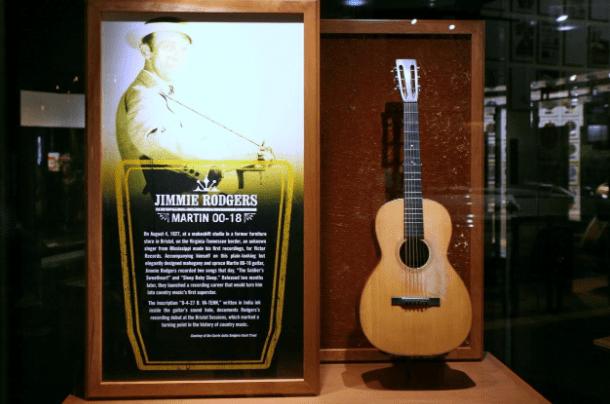
- Rodgers’ recordings sold over 12 million copies during his lifetime, making him one of the most commercially successful artists of his era.
James Charles Rodgers, aka Jimmie Rodgers, was born on September 8, 1897, near Meridian, Mississippi. His father, Aaron Rodgers, was a section foreman for the Mobile and Ohio Railroad. His mother, Eliza Bozeman Rodgers, passed away when Jimmie was around four years old. After his mother’s death, Jimmie spent several years living with relatives in Mississippi and Alabama. He eventually returned to live with his father, who had remarried.
At 14, Jimmie left school to work alongside his father on the railroad, starting as a water boy for the railroad crews and later as a brakeman. In 1924, at the age of 27, he was diagnosed with tuberculosis and forced to leave his railroad job. From that point, he pursued his love of performance at vaudeville and medicine shows, which allowed him to hone his musical skills and gain exposure to diverse audiences.
In 1927, Rodgers formed the string band called the Tenneva Ramblers, and they performed a mix of traditional and popular music on WWNC radio in Asheville, North Carolina. After a dispute over the band’s name, Rodgers continued performing solo. His breakthrough happened with “The Soldier’s Sweetheart” and “Sleep, Baby, Sleep,” songs he recorded in Bristol, Tennessee that same year. But his subsequent recording of “Blue Yodel No. 1 (T for Texas)” brought Jimmie Rodgers success, selling over a million copies. From there, he was known as “The Blue Yodeler.”

The railroad work songs and blues of the African American laborers with whom he worked significantly influenced his music, and his early vaudeville shows and traditional folk music helped develop his storytelling skills. Rodgers fused these influences into his music, which would introduce the blues to white audiences, highlighting his role in bridging the cultural and musical divide. He developed his signature yodeling style from European yodeling. He added jazz rhythms, brass, and ukulele to his recordings, along with the blend of guitar, banjo, and fiddle, creating a layered sound that would evolve into the genre of Country Music.
Throughout his career, Rodgers collaborated with various musicians and songwriters, including his sister-in-law Elsie McWilliams, who contributed to many of his songs and was inducted into the Songwriters Hall of Fame.
Rodgers’ music crossed oceans and mountains, reaching Kenya, where the Kipsigis people incorporated his music into traditional songs and created a song called “Chemirocha.” British South African Hugh Tracey recorded three iterations of the song, noting that the person/character “Chemirocha” is a Kipsigis utterance of the name “Jimmie Rodgers.”
According to Tracey, recordings of Jimmie Rodgers found their way to the village, possibly by British missionaries. Tracey surmised that the similarities between a pentatonic scale of a six-string guitar and the six-string lyre may be one reason Jimmie Rodgers’ songs moved the Kipsigis.
During Tracey’s visit, he recorded three iterations of the Kapkatet song: “Chemirocha I,” “Chemirocha II,” and “Chemirocha III.” The men perform I and II, and the young women perform “Chemirocha III.” Their high-pitched voices sing to a strumming kibugandet, a stringed instrument. In 1952, Gallotone Records released “Chemirocha II” on a 78-rpm disc, and it was released a year later on London Records and by Decca Records in the US in 1958. Also, Regal Zonophone Records distributed Jimmie Rodgers’ records in South Africa, and his music was popular among the Zulu community. Some speculate that Zimbabwe guitarists adapted Jimmie’s unique two-finger playing technique, but this speculation lacks documentation.
Jimmie Rodgers was only 35 when he took his last breath on May 26, 1933, in New York City, where he was in recording sessions. He died from complications of the disease he had battled since 1924. During his prolific recording career, he produced over 100 songs. His influence is evident in the music of Lefty Frizzell, Hank Snow, Bob Dylan, Willie Nelson, Merle Haggard, Jerry Lee Lewis, Johnny Cash, and more.
Interesting Facts
- Rodgers recorded 13 “Blue Yodels,” which blended blues progressions with his yodeling technique, creating a new subgenre within country music.
- His recordings sold over 12 million copies during his lifetime, making him one of the most commercially successful artists of his era.
Inductions and Honors
- Country Music Hall of Fame (1961)
- Songwriters Hall of Fame (1970)
- U.S. Postal Service Commemorative Stamp (1978)
- Grammy Hall of Fame (1985)
- Rock and Roll Hall of Fame (1986)
- Blues Hall of Fame (2013)
- Mississippi Blues Trail (2007)
- Americana Music Association (2014)











